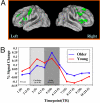Flexible neural mechanisms of cognitive control within human prefrontal cortex
- PMID: 19380750
- PMCID: PMC2678630
- DOI: 10.1073/pnas.0808187106
Flexible neural mechanisms of cognitive control within human prefrontal cortex
Abstract
A major challenge in research on executive control is to reveal its functional decomposition into underlying neural mechanisms. A typical assumption is that this decomposition occurs solely through anatomically based dissociations. Here we tested an alternative hypothesis that different cognitive control processes may be implemented within the same brain regions, with fractionation and dissociation occurring on the basis of temporal dynamics. Regions within lateral prefrontal cortex (PFC) were examined that, in a prior study, exhibited contrasting temporal dynamics between older and younger adults during performance of the AX-CPT cognitive control task. The temporal dynamics in younger adults fit a proactive control pattern (primarily cue-based activation), whereas in older adults a reactive control pattern was found (primarily probe-based activation). In the current study, we found that following a period of task-strategy training, these older adults exhibited a proactive shift within a subset of the PFC regions, normalizing their activity dynamics toward young adult patterns. Conversely, under conditions of penalty-based monetary incentives, the younger adults exhibited a reactive shift some of the same regions, altering their temporal dynamics toward the older adult baseline pattern. These experimentally induced crossover patterns of temporal dynamics provide strong support for dual modes of cognitive control that can be flexibly shifted within PFC regions, via modulation of neural responses to changing task conditions or behavioral goals.
Conflict of interest statement
The authors declare no conflict of interest.
Figures


References
-
- Koechlin E, Ody C, Kouneiher F. The architecture of cognitive control in the human prefrontal cortex. Science. 2003;302:1181–1185. - PubMed
-
- Braver TS, Gray JR, Burgess GC. In: Variation in Working Memory. Conway ARA, Jarrold C, Kane MJ, Miyake A, Towse J, editors. Oxford: Oxford Univ Press; 2007. pp. 76–106.
-
- Miller EK, Cohen JD. An integrative theory of prefrontal cortex function. Annu Rev Neurosci. 2001;21:167–202. - PubMed
-
- Jacoby LL, Kelley CM, McElree BD. In: Dual Process Theories in Social Psychology. Chaiken S, Trope E, editors. New York: Guildford; 1999. pp. 383–400.
Publication types
MeSH terms
Grants and funding
LinkOut - more resources
Full Text Sources
Miscellaneous

